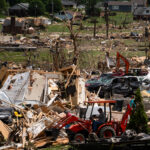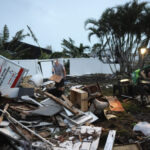Risk Management Solutions (RMS) and ImageCat, Inc., issued a joint research report Wednesday on the 2007 U.S. wildfire season. With a potential $2.5 billion in insured losses in California alone, last year ranks as one of the costliest wildfire seasons in recent history. As urban development continues to encroach on the wilderness fringes, the risk is likely to increase in the future.
In October 2007, Southern California was hit particularly hard by an outbreak of wildfires that resulted in the destruction of more than 3,000 buildings. The dry winter and summer months gave rise to abundant surface fuel, which was extremely susceptible to wildfires, and when combined with the strong Santa Ana winds ignited 23 separate fires that consumed almost 520,000 acres of land. Insured losses were primarily due to burnt residential structures and their contents, but other claims included smoke damage, additional living expenses due to the mandatory evacuation, burned automobiles, and a limited number of damaged or destroyed commercial structures.
RMS analysis reveals that, in the past ten years of California wildfire history, close to 1,350 structures have burned on average each year, with an estimated annual insured loss of some $490 million – nearly twice the long-term average. Moreover, while on average, less than 10 percent of the burnt areas in the U.S. are in California, around 70 percent of the total insured losses are from properties in Southern California. The counties between Santa Barbara and San Diego house some 60 percent of the Californian population who have been especially hard hit by wildfires.
“Housing developments are rapidly expanding into wildland areas, which create an environment in which fire can readily move between structural and vegetation fuels, increasing the threat to people and their properties,” said Patricia Grossi, senior researcher at RMS. “Last year’s California wildfires serve as a stark reminder of the need to manage and mitigate this peril through more risk-informed decisions.”
RMS teamed with ImageCat, a pioneer in disaster aerial reconnaissance technologies, to survey the damage from the 2007 Southern California outbreak. ImageCat flew four aerial reconnaissance missions over the most affected areas to derive accurate fire perimeters and build a database of destroyed structures.
“Data integration has the power to maximize accuracy and reduce uncertainties surrounding loss estimates,” said Beverley Adams, remote sensing technical director at ImageCat. RMS analyzed these datasets in conjunction with the detailed, high-resolution RMS® Wildfire Hazard Data to validate wildfire threat, susceptibility and hazard in Southern California.
Source: Risk Management Solutions
Was this article valuable?
Here are more articles you may enjoy.

 Trump Administration Targets Resiliency Funds to Shrink FEMA’s Role
Trump Administration Targets Resiliency Funds to Shrink FEMA’s Role  Here Comes Another Busy Atlantic Hurricane Season, But Will It Be as Crazy as 2024?
Here Comes Another Busy Atlantic Hurricane Season, But Will It Be as Crazy as 2024?  Will Workers’ Comp Benefit from ‘Most-Favored-Nation’ Drug Pricing?
Will Workers’ Comp Benefit from ‘Most-Favored-Nation’ Drug Pricing?  Brazil Sues EV Giant BYD Over ‘Slavery’ Conditions at Plant
Brazil Sues EV Giant BYD Over ‘Slavery’ Conditions at Plant 